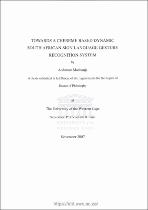| dc.contributor.advisor | Bajic, Vladimir B. | |
| dc.contributor.author | Machanja, Addmore | |
| dc.date.accessioned | 2023-06-12T08:01:53Z | |
| dc.date.available | 2023-06-12T08:01:53Z | |
| dc.date.issued | 2007 | |
| dc.identifier.uri | http://hdl.handle.net/11394/10125 | |
| dc.description | >Magister Scientiae - MSc | en_US |
| dc.description.abstract | Hand gestures are a natural and intuitive way of human to human communication.
Motivated by the achievements made towards automatic speech recognition, and by the
ease with which people sign, many researchers started working on sign language
recognition systems. Besides, technologies used to build gesture recognition systems
pose as an alternative to the cumbersome and the failure prone mechanical devices that
are currently used as human-machine interface devices. Most of the available gesture
recognition systems represent each sign language gesture with an individual gesture
model. Such systems can only recognize a limited number of dynamic sign language
gestures. It is cumbersome to build and maintain a gesture recognition system that uses
thousands and thousands of individual gesture models. Sign language linguists argue
that all sign language gestures are derived from small sets of reusable components, the
cheremes. | en_US |
| dc.language.iso | en | en_US |
| dc.publisher | University of the Western Cape | en_US |
| dc.subject | South Africa | en_US |
| dc.subject | Sign language | en_US |
| dc.subject | Technology | en_US |
| dc.subject | Computer Science | en_US |
| dc.title | Towards a chereme based dynamic South African sign language gesture recognition system | en_US |
| dc.rights.holder | University of the Western Cape | en_US |

